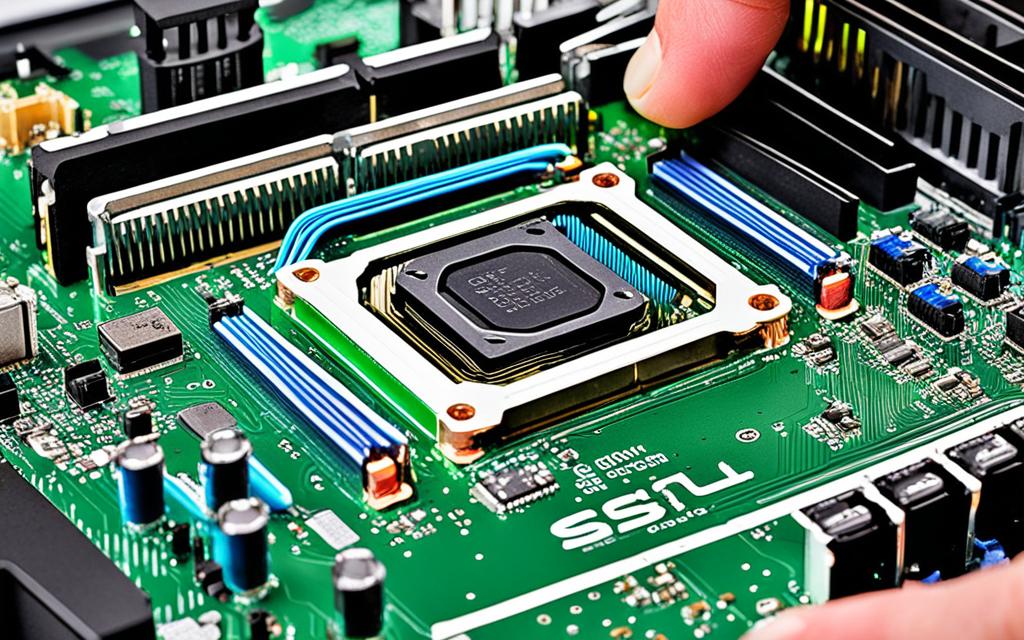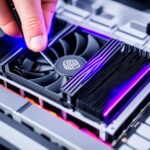Table of Contents
Replacing a CPU cooler might look tough, but it’s crucial for your computer’s top performance. A good cooler makes your computer parts last longer, cuts down on waste, and helps the planet. Knowing how to cool your processor well is key. This stops overheating during heavy computer use.
This guide will show you how to change your CPU cooler. It is for everyone, from experts to those just starting. You will learn vital tips on installing a CPU cooler. This knowledge is important for taking care of your PC12.
Key Takeaways
- Understanding the necessity of replacing your CPU cooler can enhance overall performance.
- Choosing between air coolers and liquid coolers is crucial for effective cooling.
- Correct thermal paste application is vital for optimal heat transfer.
- Compatibility with your CPU socket ensures a successful installation.
- Learning the installation process can empower you in DIY PC maintenance.
Understanding the Importance of CPU Cooling
The importance of CPU cooling cannot be understated in the world of computing. Processors are doing more work than ever before. This makes good thermal management vital. Knowing how CPU coolers work shows us why they’re so crucial.
How a CPU Cooler Works
A good CPU cooler is key in getting rid of the heat from the processor. It moves the heat to the air or liquid around it. This process, based on thermal conductivity, is what boosts the CPU cooler functionality. Enthusiasts often talk about. There are air coolers, which use fans to push the heat away. Then there are liquid coolers, which take the heat into a fluid before getting rid of it.
Consequences of Poor Cooling
Not cooling your CPU properly can lead to big problems. Your system’s performance might drop, or it could crash. Over time, the heat can even damage parts of your computer. This is why keeping things cool, especially when overclocking, is so important. Overclocking can make your computer run faster but can also make it unstable without proper cooling. Cooling fans play a crucial role. They make sure the CPU doesn’t get too hot during intense tasks, avoiding overheating issues3.
Liquid cooling is great for keeping temperatures stable. But, not all liquid cooling systems are created equal. The cheaper ones might not cool as well as top-notch air coolers. This is why choosing the right cooling system for your needs is critical4.
| Cooling Type | Key Features | Performance | Space Requirements |
|---|---|---|---|
| Air Cooling | Utilises fans, cost-effective | High performance, reliable | Less space required |
| Liquid Cooling | Efficient heat transfer, quieter | Excellent for overclocking | Requires more space |
Types of CPU Coolers
Understanding the different CPU coolers can help make your PC work better and stay cool. There are mainly two types: air coolers and liquid coolers. Each one offers unique advantages for different needs and tastes.
Air Coolers vs Liquid Coolers
Air coolers are quite popular, especially for mid-range computers. They often come with the CPU and are more affordable than liquid coolers. You can find many air coolers for under $305. But for those who want the best, some top-quality air coolers can go above $1005. Air coolers are easy to set up and don’t cost much.
Liquid coolers use different technology, like AIO (All-In-One) systems, which are getting more popular. AIOs are simpler to install and have fewer parts than custom-built systems. Custom systems are more complex and can leak6. For extreme cooling, immersion cooling is very effective but costs a lot more6.
Choosing the Right Cooler for Your Build
When picking the best CPU cooler, consider size, performance needs, and how much you want to spend. Compact PCs do well with low-profile coolers under 70mm. Bigger models, like the Noctua NH-U14S TR4-SP3, are good for AMD Threadripper setups. For liquid cooling, the Lian Li Galahad II Performance 360 or Arctic Liquid Freezer II 360 ARGB are excellent choices5.
Choosing between air cooling and liquid cooling depends on what you need for your PC. Looking at all the options can help you find the best way to improve your computer’s performance.
Prerequisites for Replacing Your CPU Cooler
Before you replace your CPU cooler, you need to prepare carefully. You must pick the right tools and materials. This will make sure your system’s cooling upgrade goes smoothly and improves its performance.
Essential Tools and Materials
Start by getting these key tools ready:
- Thermal paste for optimal heat transfer.
- A magnetic screwdriver set, such as the Amartisan set, makes installation easier7.
- Alcohol swabs to clean the CPU surface before you apply new thermal paste7.
Depending on the cooler, you might need particular tools. For example, air coolers are generally simpler to fit because of their design. But, liquid coolers often require more bits like extra fittings and tubes.
Checking Compatibility with Your CPU
It’s vital to check cooler compatibility with your CPU. Make sure the cooler fits your CPU’s socket type. For instance, a Ryzen AM5 processor must align with an AM4 socket for correct fitting7.
If your CPU has a Thermal Design Power (TDP) over 150W, choose a cooler that can handle that power8. The cooler’s effectiveness also depends on fan speed, pump speed, and the density of the heat sink8. Always look at reviews to understand how well different coolers perform and if they’re compatible.
How to Replace CPU Cooler
Replacing your CPU cooler can boost your system’s performance and its lifespan. First, make sure your work area is tidy and organised. This helps you have all necessary tools ready, making the process easier and more efficient. Getting ready is crucial for a smooth replacement.
Preparing Your Work Area
Start by cleaning your workspace and getting rid of static. You will need a screwdriver, thermal paste, and your new CPU cooler. An anti-static wrist strap is also good to have. This stops damage to the parts. Having your tools in order makes the work flow better when installing the cooler.
Step-by-Step Installation Process
Here is how to install your new cooler:
- First, shut down your PC and unplug it.
- Take off the old CPU cooler. You might need to unscrew or unclip it.
- Gently clean the CPU with isopropyl alcohol to take off old thermal paste.
- Put a small dot of thermal paste on the CPU. Too much paste can make it overheat.
- Place the new cooler on the CPU, making sure it fits well.
- Fix the cooler in place with the right hardware. Each cooler has its instructions.
- Plug the CPU fan cable into the motherboard. This is important for the cooler to work well.
- Check everything is secure before you plug in and turn on the PC again.
Look at the cooler’s CFM rating and noise level for the best performance and sound control. Make sure the end result meets what you need9. Doing these steps helps your CPU stay cool, even under big loads10. After, use software to check your system’s temperatures to see if everything is working right.
Troubleshooting Common Issues
It’s important to fix common CPU cooler issues to keep your system running well. Overheating is a big problem with CPUs. It can make your system crash, shut down unexpectedly, or slow down11. By solving overheating problems, you can make your system cooler and more stable.
Overheating Problems
Knowing the signs of overheating is key. Look out for sudden shutdowns or your system slowing down11. Keep an eye on CPU temperatures and make sure there’s good airflow to stop overheating11.
Cleaning CPU fans is important. Turn off and unplug your computer. Open the case and clean the fans with air guns or canned air, but don’t use cleaning liquids12. Sometimes, a CPU fan error message means there’s physical damage or the settings are wrong12.
Noise Issues from the Cooler
If your CPU fan is too loud, you need to check it. Make sure the fan is properly attached and connected to the motherboard12. This stops unwanted noise and vibrations. If it’s still noisy, try changing the fan’s settings in the BIOS or disable the fan speed monitor12. This might stop error messages if other steps don’t work.
Dealing with CPU cooler issues properly can make your computer quieter and work better. Keep the fans clean and reapply thermal paste to avoid overheating11. If your CPU is working too hard without any demanding tasks, look for old drivers or programs that use too much power. This can prevent further problems with your cooler11.
Conclusion
Having a good CPU cooler is key to keep your computer running well and for a long time. Coolers are vital because modern CPUs get very hot. An effective cooler stops your computer from slowing down or turning off suddenly13. It’s also important to know about different coolers, so you can choose the best one for you. Your choice should match what you need and how much you can spend14.
Keeping your cooler clean and replacing it if it gets too hot or loud is also crucial13. Changing your CPU cooler shows how important it is to look after your computer. It can also help the planet by reducing waste if we upgrade our computers instead of throwing them away15.
Remember, replacing your CPU cooler is not just about your computer’s performance. It’s about being responsible with your tech. Stay confident in your skills to improve your setup. A little effort can make your computing experience better for years. For more tips on upgrading your system, check out this comprehensive guide.
FAQ
What are the signs that my CPU cooler needs to be replaced?
Look out for system crashes and unexpected shutdowns. High CPU temperatures are a red flag. If your cooler is noisy or your computer slows down, consider getting a new one.
Can I use an air cooler with high-performance CPUs?
Sure, many air coolers can handle powerful CPUs. Just ensure the cooler is right for your CPU’s TDP. Also, it needs to fit in your case for good airflow.
How do I ensure my new CPU cooler is compatible with my CPU?
Check the cooler’s specs for CPU socket compatibility. Ensure it meets your CPU’s power and size needs too.
What tools do I need to replace my CPU cooler?
You’ll need a screwdriver, thermal paste, and maybe a cleaning cloth. Gather these before you start for a smooth process.
Is liquid cooling worth the investment?
For gamers or those who overclock, liquid cooling offers better cooling. But for most, air cooling is enough and saves money.
What type of thermal paste should I use with my CPU cooler?
Choose a high-quality thermal paste for best results. Brands like Arctic Silver and Noctua NT-H1 are great for effective cooling.
How often should I replace my CPU cooler?
CPU coolers last years, but inspect them now and then for dust and check if they work well. Replace if cooling efficiency drops.
Can I install a CPU cooler without prior experience?
Yes, with a careful approach and following a guide, beginners can install a cooler. Follow instructions closely for best results.
How do I apply thermal paste correctly?
Put a pea-sized thermal paste on the CPU centre. The cooler’s pressure will spread it evenly. Don’t use too much to avoid issues.
What should I do if my new cooler is making noise?
Make sure it’s installed right and nothing blocks it. If it’s still noisy, look for loose parts. Follow the maker’s advice for more help.
Source Links
- https://www.xda-developers.com/how-to-install-cpu-cooler/ – How to install a CPU cooler: A beginners guide
- https://www.rockpapershotgun.com/how-to-install-a-cpu-cooler – How to install a CPU cooler
- https://sofasco.com/blogs/article/role-of-cpu-cooling-fans-in-ensuring-stable-overclocking-performance – Role of CPU Cooling Fans in Ensuring Stable Overclocking Performance
- https://discourse.mcneel.com/t/cpu-liquid-vs-air-cooling/119788 – CPU: Liquid vs Air Cooling
- https://www.tomshardware.com/reviews/best-cpu-coolers,4181.html – Best CPU Coolers 2024: AIO and Air Coolers
- https://www.makeuseof.com/types-of-cpu-coolers-which-should-you-use/ – The 3 Types of CPU Coolers (and Which One You Should Use)
- https://www.pcguide.com/cpu/how-to/replace/ – How to replace a CPU in a few easy steps (with pictures)
- https://www.makeuseof.com/what-to-look-for-when-buying-a-cpu-cooler/ – 8 Factors to Consider Before Buying a CPU Cooler
- https://superuser.com/questions/1414921/possible-to-replace-cpu-fans – Possible to replace CPU fans?
- https://www.thegamer.com/install-a-cpu-air-cooler-gaming-pc/ – A Beginner’s Guide To Installing A CPU Cooler For Your Gaming PC
- https://gadgetmates.com/troubleshooting-common-cpu-issues – Troubleshooting Common CPU Issues: Quick Fixes and Expert Tips – GadgetMates
- https://www.lifewire.com/fix-cpu-fan-error-4687270 – How to Fix a CPU Fan Error
- https://ms.codes/en-ca/blogs/computer-hardware/how-to-replace-cpu-cooler – How To Replace CPU Cooler
- https://softwareg.com.au/blogs/computer-hardware/how-to-replace-cpu-cooler – How To Replace CPU Cooler
- https://www.electronicshub.org/how-to-install-cpu-cooler/ – How To Install A CPU Cooler?








